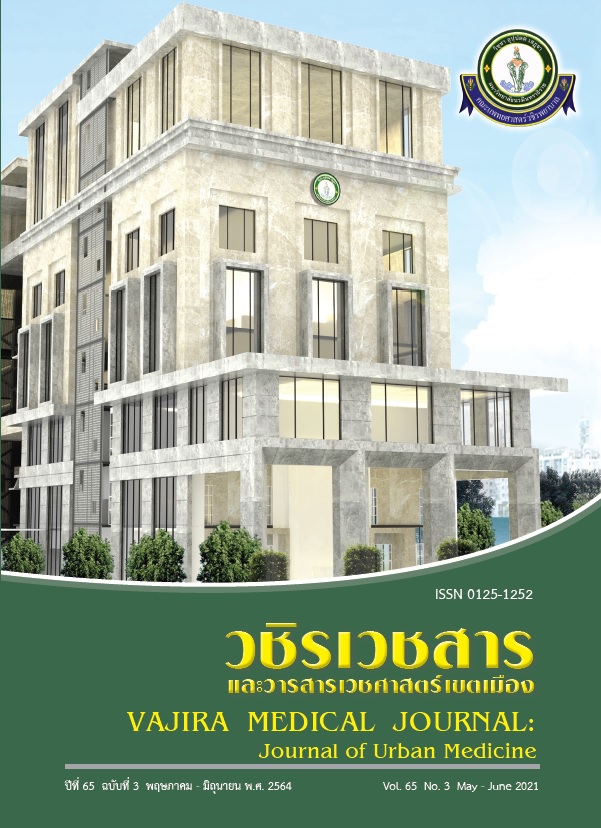Driving Pressure and Lung Injury in Mechanically Ventilated Patients without Acute Respiratory Distress Syndrome -
Main Article Content
Abstract
Background: Driving pressure is associated with mortality in patients with acute respiratory distress syndrome (ARDS). However, whether driving pressure is associated with outcomes in mechanically ventilated patients without ARDS is unknown.
Objective: This study primarily aimed to determine the association between driving pressure and severe lung injury (lung injury score ≥ 2.5). The secondary outcomes were to determine the cutoff point of driving pressure associated with severe lung injury and compare patient mortality between severe and non-severe lung injury score in mechanically ventilated patients without ARDS.
Methods: Mechanically ventilated patients without ARDS admitted in the intensive care unit (ICU) of Faculty of Medicine Vajira Hospital, Navamindradhiraj University, Bangkok, Thailand, between 2018 and 2020 were enrolled. Baseline characteristics including sex, age, diagnosis, sedative drug, and lung mechanic from the ventilator were recorded. Moreover, the patients’ driving pressure [plateau pressure–positive end expiratory pressure (PEEP)] and lung injury score were obtained. Multivariable logistic regression analysis was performed to determine associations between driving pressure and patient lung severity with lung injury score. The mechanically ventilated patients without ARDS were categorized according to lung injury score ≥ 2.5; then, a severe form of the area under the receiver operating characteristic (AuROC), as a dependent outcome, was observed to determine the association between driving pressure and severe lung injury. The optimal cutoff point of driving pressure that determined severe lung injury was calculated by Youden’s index.
Result: In total, 155 mechanically ventilated patients without ARDS were enrolled. Overall mortality was 28.3%. Driving pressure was associated with severe lung injury (OR, 1.28; 95% CI, 1.15–1.42; p-value <0.001). A good discriminative ability of driving pressure to determine severe lung injury was noted (AuROC = 0.859; 95%CI, 0.768–0.950). The optimal cutoff point of driving pressure indicating severe lung injury was 16 cmH2O with, 89.5% sensitivity (95% CI, 66.9–98.7), 75% specificity (95% CI, 66.9–82.0), 33.3% positive predictive value (95% CI, 20.8–47.9), and 98.1% negative predictive value (95% CI, 93.2–99.8).
Conclusion: In mechanically ventilated patients without ARDS, increased driving pressure was associated with severe lung injury. A driving pressure >16 cmH2O was associated with severe lung injury.
Downloads
Article Details
References
Gattinoni L, Carlesso E, Caironi P. Stress and strain within the lung. Curr Opin Crit Care 2012;18:42-7.
Protti A, Votta E, Gattinoni L. Which is the most important strain in the pathogenesis of ventilator induced lung injury: dynamic or static. Curr Opin Crit Care 2014;20:33-8.
Protti A, Andreis DT, Monti M, Santini A, Sparacino CC, Langer T, et al. Lung stress and strain during mechanical ventilation: any difference between statics and dynamics. Crit Care Med 2013;41(4):1046-55.
Katira BH, Engelberts D, Otulakowski G, Giesinger RE, Yoshida T, Post M, et al. Abrupt deflation after sustained inflation causes lung injury. Am J Respir Crit Care Med 2018;198:1165-76.
Tongyoo S, Permpikul C, Mongkolpun W, Vattanavanit V, Udompanturak S, Kocak M, et al. Hydrocortisone treatment in early sepsisassociated acute respiratory distress syndrome : results of a randomized controlled trial. Crit Care 2016; 20:329.
Atabai k, Matthay MA. The pulmonary physician in critical care.5: acute lung injury and the acute respiratory distress syndrome: definitions and epidemiology. Thorax 2002;57:452–8.
Murray JF, Matthay MA, Luce JM, Flick MR. An expanded definition of the adult respiratory distress syndrome. Am Rev Respir Dis 1988;138:720-3.
Soto GJ, Kor DJ, Park PK, Hou PC, Kaufman DA, Kim M, et al. Lung injury prediction score in hospitalized patients at risk of acute respiratory distress syndrome. Crit Care Med 2016;44:2182–91.
Amato MBP, Meade MO, Slutsky AS, Brochard L, Costa ELV, Schoenfeld DA, et al. Driving pressure and survival in the acute respiratory distress syndrome. N Engl J med 2015;372:747-55.
Talmor D, Sarge T, Malhotra A , Donnell CR, Ritz R, Lisbon A, et al. Mechanical ventilation guide by esophageal pressure in acute lung injury. N Engl J Med 2008;359:2095-104.
Papazian L, Forel JM, Gacouin A, Penot-Ragon C, Perrin G, Loundou A, et al. Neuromuscular blockers in early acute respiratory distress syndrome. N Engl J Med 2010;363:1107-16.
Determann RM, Royakkers A, Wolthuis EK, Vlaar AP, Choi G, Paulus F, et al. Ventilation and lower tidal volumes as compared with conventional tidal volume for patients without lung injury : a preventive randomized controlled trial. Crit Care 2010;14(1):R1.doi: 10.1186/cc8230. Pubmed PMID:20055989.
Fuller BM , Mohr NM , Drewry AM , Carpenter CR. Lower tidal volume at initiation of mechanical ventilation may reduce progression to acute respiratory distress syndrome: a systemic review. Crit Care 2013;17(1):R11. doi: 10.1186/cc11936. Pubmed PMID:23331507.
Bellani G, Laffey JG, Pham T, Fan E, Brochard L, Esteban A, et al. Epidemiology, patterns of care, and mortality for patients with acute respiratory distress syndrome in intensive care units in 50 countries. JAMA 2016;315:788-800.
Fanelli V, Vlachou A, Ghannadian S, Simonetti U, Slutsky AS, Zhang H. Acute respiratory distress syndrome: new definition, current and future therapeutic options. J Thorac Dis 2013;5:326-34.
Loring SH, Malhotra A. Driving pressure and respiratory mechanics in ARDS. N Engl J med 2015;372:776-7.
Nuckton TJ, Alonso JA, Kallet RH, Daniel BM, Pittet JF, Eisner MD, et al. Pulmonary deadspace fraction as a risk factor for death in the ARDS. N Engl J Med 2002;346:1281-6.
Gattinoni L, Pesenti A. The concept of “baby lung”. Intensive Care Med 2005;31:776-84.
Schmidt MFS, Amaral A, Fan E, Rubenfeld GD. Driving pressure and hospital mortality in patients without ARDS: a cohort study. Chest 2018;153:46-54.
Neto As, Barbus CS, Simonis FD, Raventos AA, Canet J, Determann RM, et al. Epidemiological characteristics, practice of ventilation, andclinical outcome in patients at risk of acute respiratory distress syndrome in intensive care units from 16 countries (Provent) : an international multicentre, prespective study. lancet Respir Med 2016;4:882-93.


